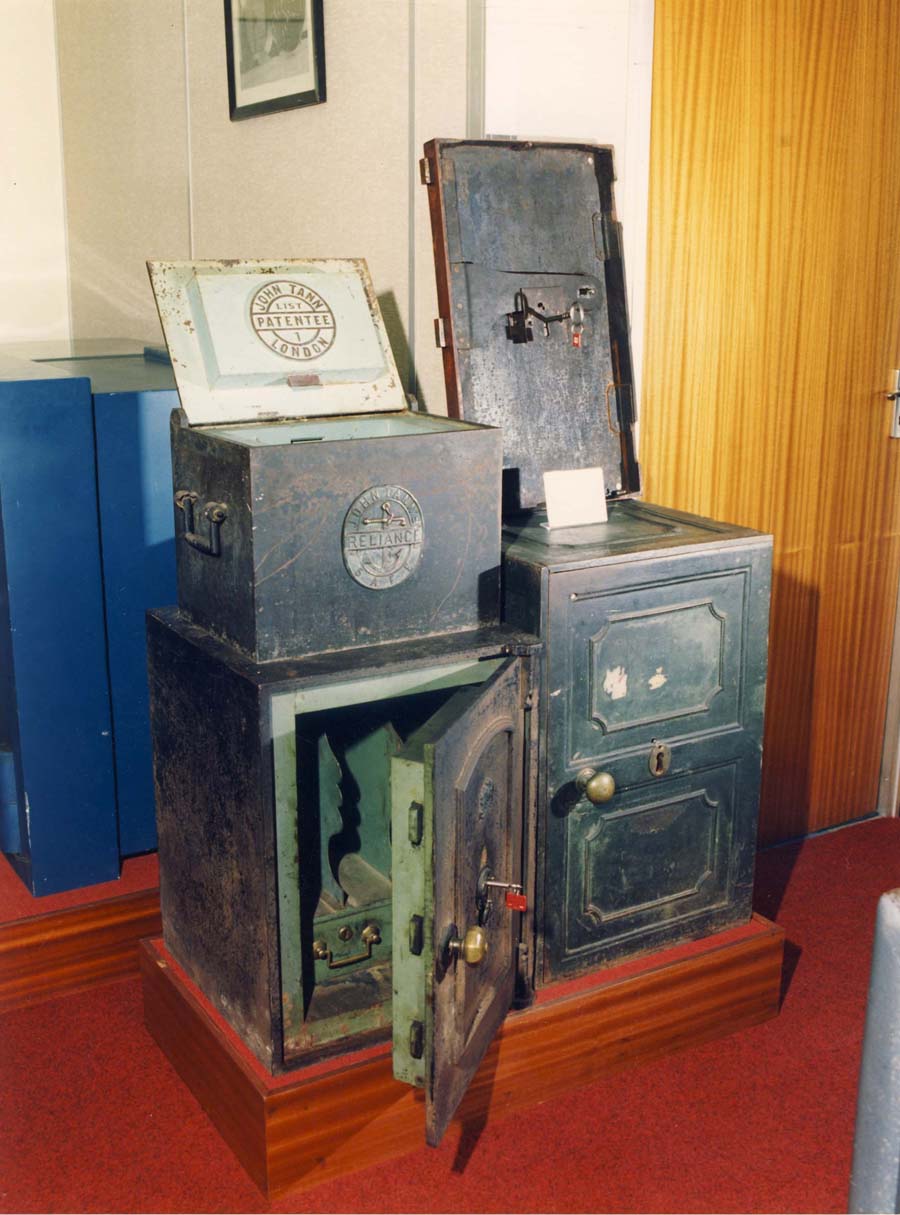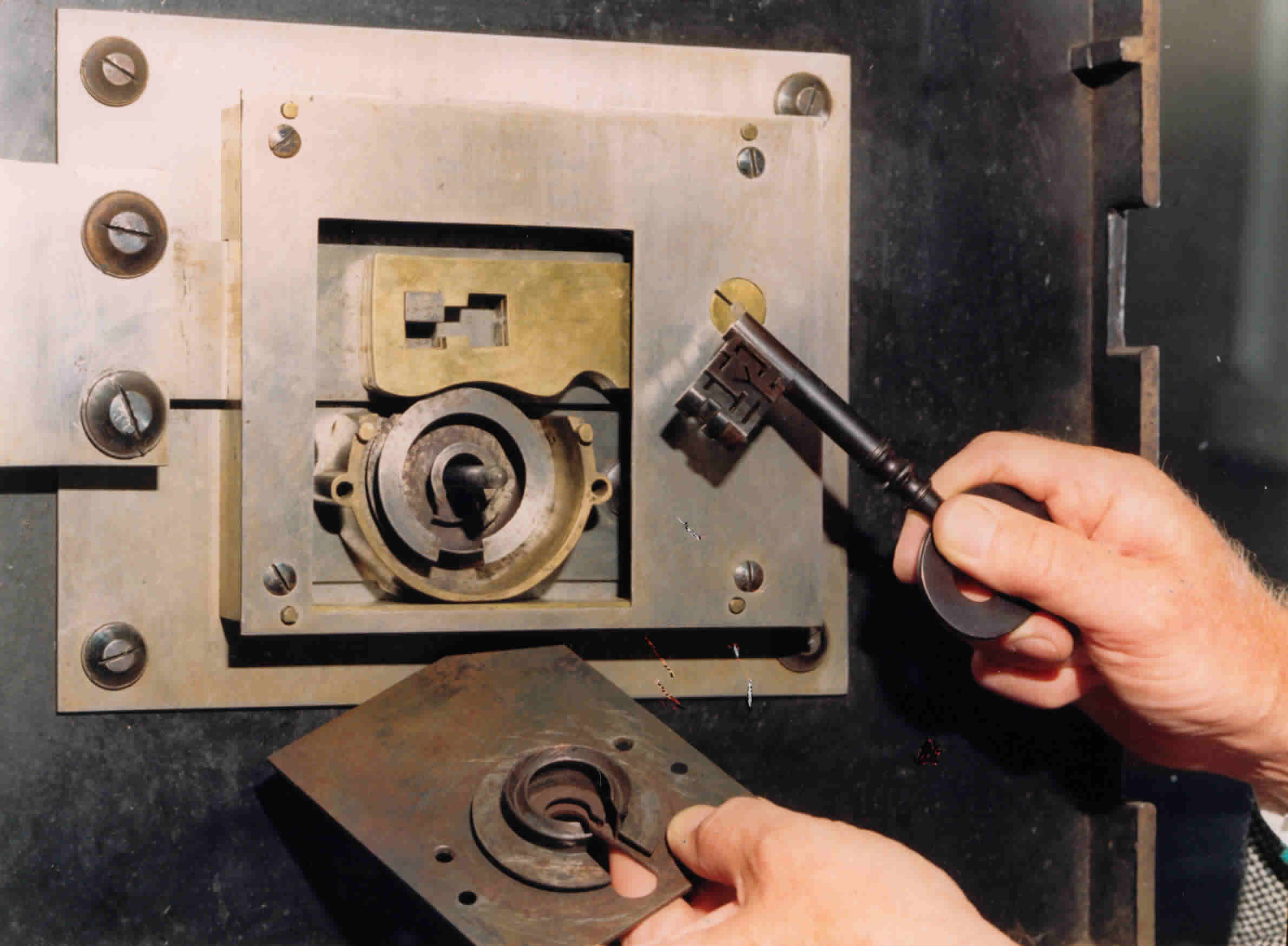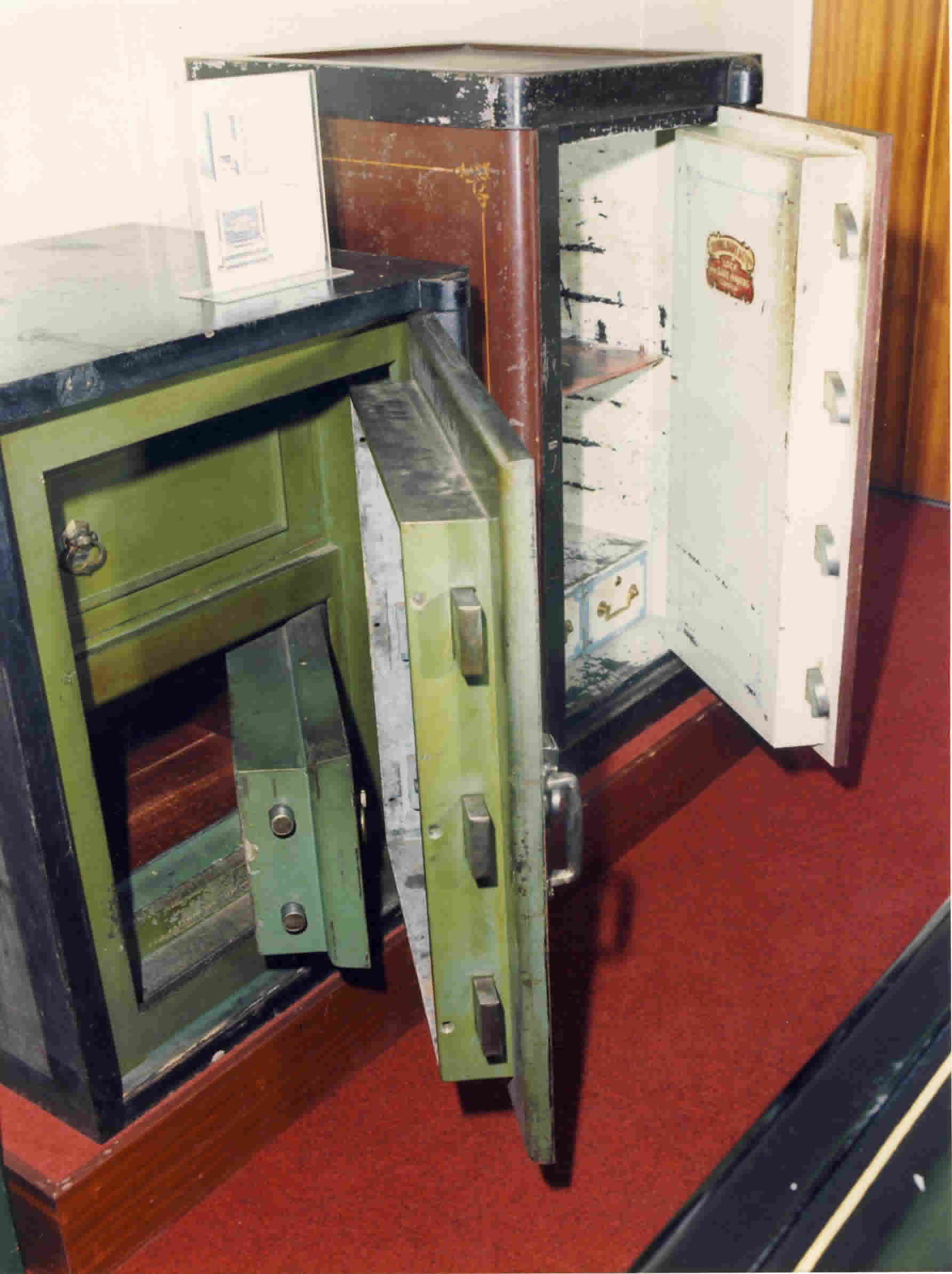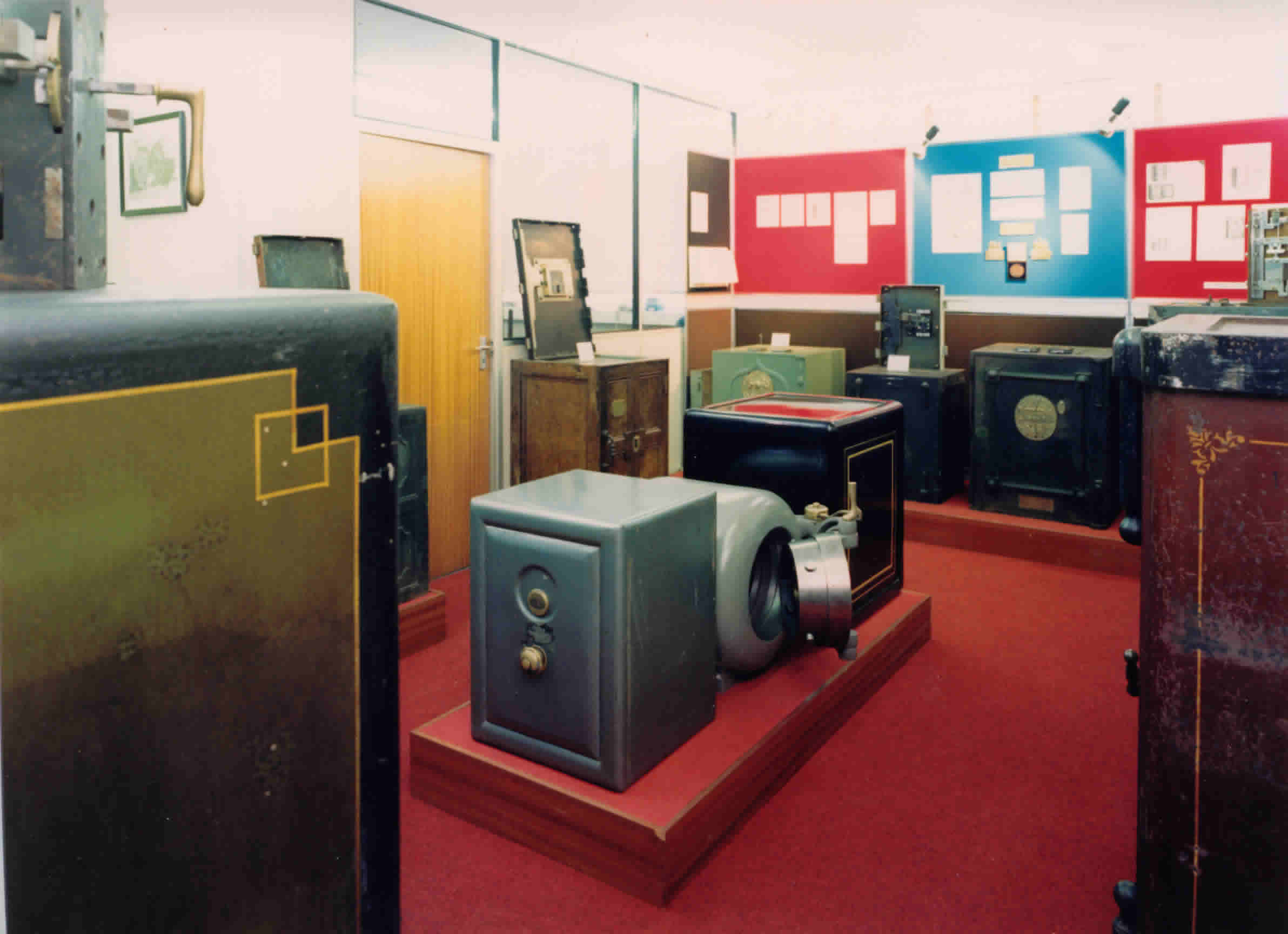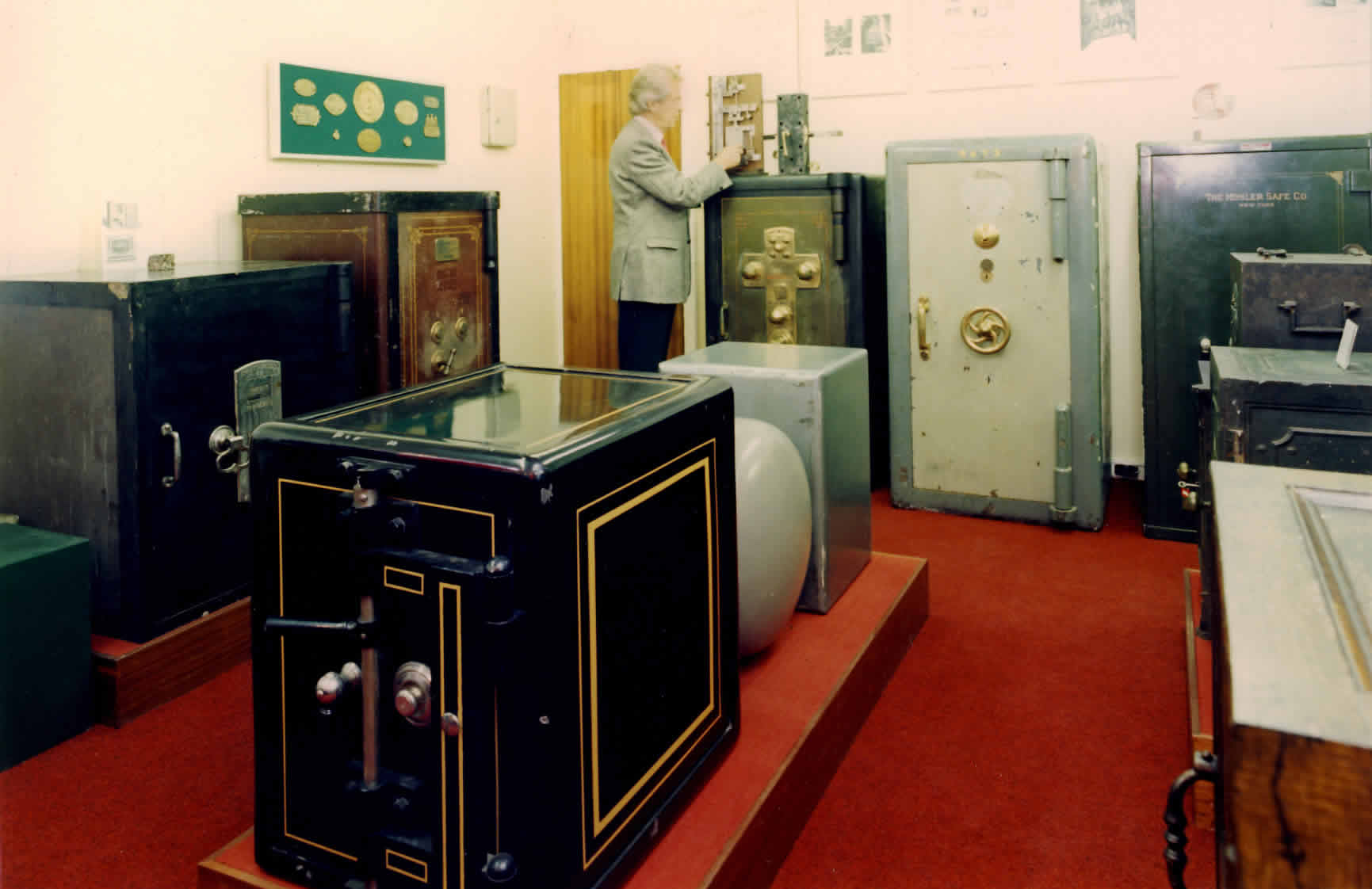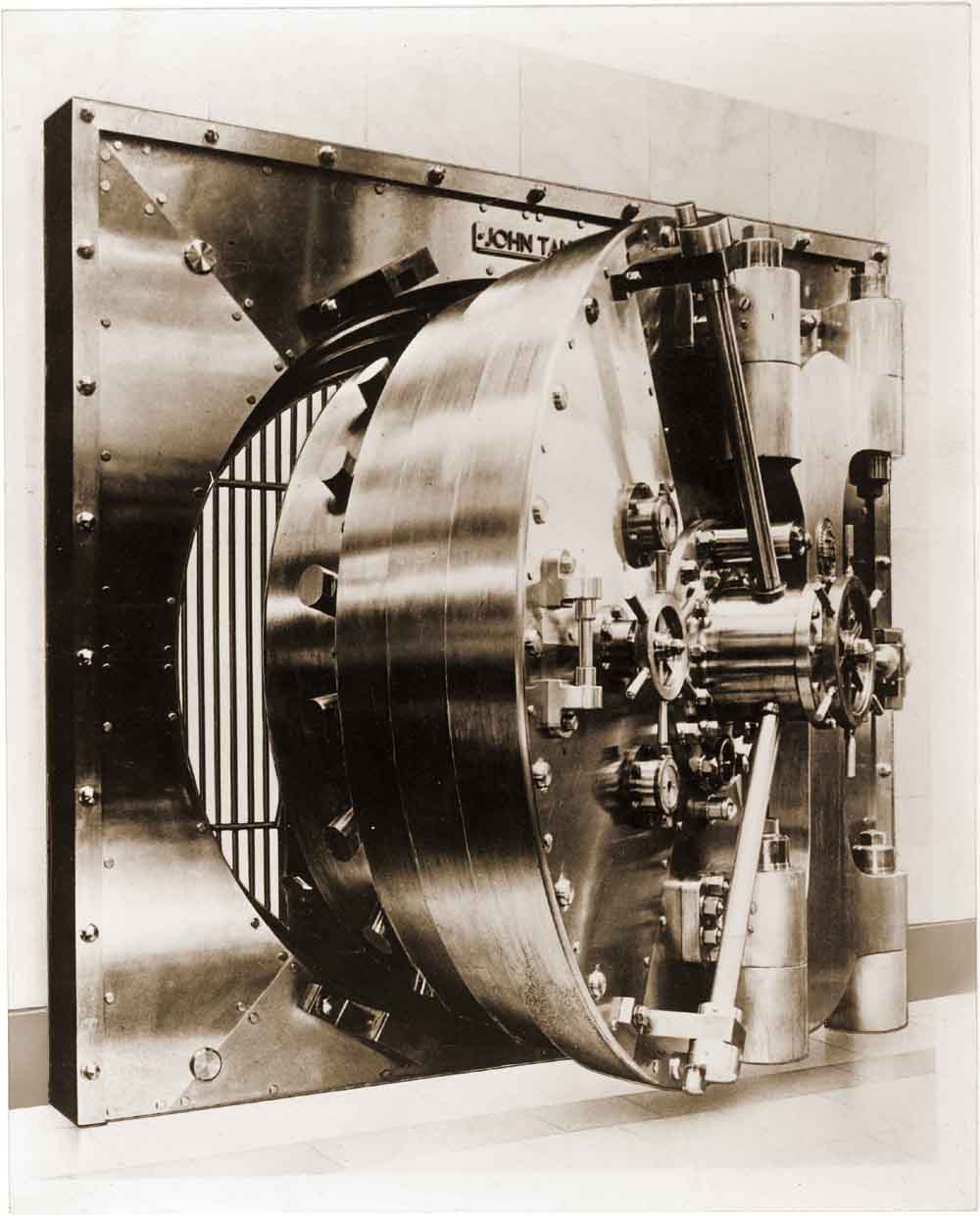To the best of my knowledge the safe museum was created in the early 1980's in the basement of J.W.Levy & Son in Thavies Inn House, Holborn Circus, by their then Insurance Liasion advisor, D.E.Bûgg. The purpose was to enlighten Burglary Insurance Surveyors and Police Crime Prevention Officers on the construction of older safes which in turn would better equip them to make an accurate evaluation of their security potential.
Don Bûgg was succeeded by Richard Sweetman then subsequently by Mike Palmer until the time Levys closed their City office in 1985. Not until the company fully merged with John Tann Security later that year was the museum resurrected within the Tann factory at Borehamwood, Herts.
In Tanns, quite a small area was allocated to the museum and it was at that time the accompanying photographs were taken. As the facility grew in popularity it was decided to enlarge and reform it into a customer relations centre combining factory visits, demonstrations, and presentations covering the history and development of safe manufacture over the years. Unfortunately no photographic record was taken of the enlarged museum which eventually displayed 41 safes by most British makers from the late 1700's to 1938. Even more unfortunately the new management of Tann disposed of the entire collection in 1992.
In the original museum all the safes had been fully refurbished and spray painted in a silver hammer finish as illustrated below, but it was my belief that their purpose would be better served in presenting them as nearly as possible in their original livery, warts and all.
JM
This safe by Milners Safe Co. is very much a special, possibly meant as a demonstation piece as it conforms to no known specification.
The back bolts - unseen here - are of a vertical sliding triangular form which slide into vertical "T" slots recesses in the body. (Wm.Milner & Daniel Rowlinson Ratcliff Patent No.903 - 1865) Otherwise the boltwork is a conventional 3-way system.
The plate is not original.
Group of three of the oldest safes in the small museum. The chest is a Tann List 1 fully lined with fire chambers.
Beneath that is a fire-resistant safe with a made-up door and bolts operated by the keylock, possibly made by Tann as the hinge design suggests.
On the right is a cast iron chest by the Carron Iron Company. The lock shown on top is a very basic wheel lock.
Below is the Bankers Chest by Jas.Gray of Edinburgh (c.1830) already featured elsewhere on this site - with the lockcase presented for inspection. The drop handles have been removed allowing the chest to be stood upright. Close up of the lock shows that in addition to the fine warding the key operates three levers with extremely tight tolerances in the gating.
The key as shown here was misappropriated from the offices of Rosengrens Tann in Letchworth where the safe had been on display. As the author is the owner of this safe he will be 'more than grateful' if it can be reunited with the lock.
Moving up the century, the safe on the left is an example of one of Milner's first wrought iron safes, a List 2, No.40845 (1854). It features two of the items referred to in the Quadruple Patent of 1854, i.e. filling all the free space in the chamber with wood (see chamber lying alongside safe extreme left of photograph), and the first powder-proof lock by Hobbs, which, unusually for a safe lock, shoots upwards.
The safe in the centre is a John Tann List 2a, sometimes known as the M.M. quality. (machine made).The basic locking mechanism is shown on top. This particular safe is No.10473 (c.1883) and it is believed to have been in continuous production for nearly 50 years from 1860 to 1920.
The safe on the right - also pictured elsewhere on the site - is a John Tann List No.3 number 7555 (1880). It embodies the main features of the 1865 Patent No.695. Although the pull handle is missing, the boltwork was operated by a removable "T" handle through the hole at the bottom of the name plate. This model remained in production until about 1908.
The safe on the left is a Chatwood List 4a (composite) i.e.containing a coffer. Its date is approximately 1890. It is a special in that it falls between sizes 6 and 7. The List 4 is constructed of 1/2" body plates (machine fitted dovetail) plus strong angle irons and cone headed rivets with a "T" girder frame.
The coffer is constructed of Chatwood's Patent Intersected Steel - "undrillable under any circumstances" (sic) - otherwise known as Spiegeleisen, an iron-manganese alloy.
Behind the Chatwood is a Hobbs Hart "Progress D" size number 10, safe No.27449 (c)1908, fitted with Hobbs & Co's Patent Clutch Bolts (porpoise action) "Mechanism secured and controlled by Hobbs and Co's patent 'Protector' unpickable safe locks, one of which is gunpowder proof".
A general view of part of the museum showing the constrictions of space. The island plinth displays one of the earliest Chatwood Duplex models - No. S 50355 (c.) 1930.
In this model Chatwood reversed the usual order of protection by placing the heaviest body plates on the inside i.e. 3/16"outer shell and 3/8" inner lining. The door was cast hollow with an infil of fondu cement. It also incorporated facilities for floor anchoring.
In the centre is the Chatwood Cylinder Safe No.37404 (c.1928). Crane hinging permitted the door to enter the body by direct thrust. The model was supplied in quantity to Allied Dairies in 1928.
Taken from the opposite end, the safe in the forefront is American as is the large green one in the right background. They are both products of the Mosler Safe Co. and the reason for their inclusion is more sentimental than instructional.
The Levy Company where the museum was founded was established in 1888 by the grandfather of the last Chairman, Josh Levy. Joshua W Levy Snr. quit the sea while in America and took work with the Mosler Safe Co. When he returned to London he brought with him the agency for Moslers setting up his business at Holborn Circus. American safe makers have always favoured combination locks which had an unfortunate consequence for Mosler in Britain when in one of his short stories, Sherlock Holmes stated that this type of locking was less than secure.
In the background stands the heaviest of the exhibits, a Chatwood Diamond Quality and a Ratner Grade 7. The lock and boltwork of both are shown below.
The Chatwood No.26696 (c.1905) is sometimes referred to as the "Octuple Patent Intersected Steel Safe".
The very large cruciform escutcheon plate (see above) incorporates a 5 spindle combination letter lock, a keyway protected by hardened steel shutter, and the operating handles.
The sliding dovetail clawbolts are cross-locked by part of the main lock (see brass scroll wheel above main bronzed bolt operating mechanism).
Despite the beauty of the mechanism, it could be said to be grossly over-engineered for its purpose. It sold at a list price of £279.15.0.
The Ratner Grade 7 No.42393 was made in 1925. Locked by Ratner's Patent Letter lock which operated drill-resisting shields over the two keyways. The 3-way boltwork is protected by one automatic 'safety bolt' (relocker) which can be seen centre top as an inclined stop to the leading bolts and operated by the top keylock.
Dead relockers are also visible at two points down the left hand side which will relock behind the up and down tail straps should the locks to which they are attached be destroyed.
Both the Chatwood and Ratner are top of the range fire and burglar resisting safes, designed to resist all methods of attack from lock picking, drilling, wedging, thermal cutting, and explosives.
Although only on display in the museum as a photograph on the wall behind the image of the 'three oldest safes', this photograph could always be counted on to draw comment from visitors.
It is of the circular vault door which was made for the Bank of Greece. No.50700, it was manufactured in 1933 and the final installation was completed 1935.
Copyright © 2009 All rights reserved

